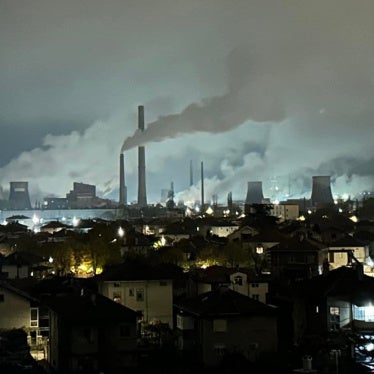Recent satellite images released by the UN program UNOSAT confirm the widespread torching of ethnic Georgian villages inside South Ossetia, Human Rights Watch said today. Detailed analysis of the damage depicted in five ethnic Georgian villages shows the destruction of these villages around the South Ossetian capital, Tskhinvali, was caused by intentional burning and not armed combat.
“Human Rights Watch researchers personally witnessed Ossetian militias looting and burning down ethnic Georgian villages during their research in the area,” said Rachel Denber, deputy director of the Europe and Central Asia division of Human Rights Watch. “These satellite images indicate just how widespread the torching of these villages has been in the last two weeks.”
The new satellite images, taken by a commercial satellite on August 19, were analyzed by experts of the Geneva-based UNOSAT program, which is part of the UN Institute for Training and Research and produces satellite-derived mapping in support of UN agencies and the international humanitarian community. UNOSAT experts identified visible structures on the images that were likely to have been either destroyed or severely damaged. The expert analysis indicates clear patterns of destruction that are consistent with the evidence gathered by Human Rights Watch researchers working in the region.
  Click on image to see destruction of houses Click on image to see destruction of houses |
Among the images publicly available from the UNOSAT website (http://unosat.web.cern.ch/unosat/) is a map marking satellite-detected active fire locations in the ethnic Georgian villages around Tskhinvali. The map shows active fires in the ethnic Georgian villages on August 10, 12, 13, 17, 19 and 22, well after active hostilities ended in the area on August 10. On these dates the lack of cloud cover allowed the satellites to view those locations.
- Fires by date (high resolution, 3.3MB)
- Fires by date (low resolution, 1.6MB)
UNOSAT has also released a set of six high-resolution satellite images of the enclave of ethnic Georgian villages stretching nine kilometers north from Tskhinvali, showing that the majority of them have been destroyed.
- Destroyed ethnic Georgian villages (high resolution, 26.7MB)
- Destroyed ethnic Georgian villages (low resolution, 8.5MB)
The images strongly indicate that the majority of the destruction in five of the villages – Tamarasheni, Kekhvi, Kvemo Achabeti (Nizhnie Achaveti in Russian), Zemo Achabeti (Verkhnie Achaveti in Russian), and Kurta – was caused by intentional burning. The high-resolution images of these villages show no impact craters from incoming shelling or rocket fire, or aerial bombardment. The exterior and interior masonry walls of most of the destroyed homes are still standing, but the wood-framed roofs are collapsed, indicating that the buildings were burned. Only along the main road through Tamarasheni are a number of homes visible with collapsed exterior walls, which may have been caused by tank fire. Ethnic Georgian witnesses from Tamarasheni told Human Rights Watch that they had witnessed Russian tanks systematically firing into the homes on August 10.
On August 12, Human Rights Watch researchers witnessed massive looting by Ossetian militias in Tamarasheni, as well as in the neighboring ethnic Georgian villages. Human Rights Watch researchers saw and photographed the still-smoldering and the recently torched houses in Tamarasheni. Witnesses from local villagers in Tamarasheni, Kvemo Achabeti, and Kekhvi told Human Rights Watch that Ossetian militias were systematically looting and burning ethnic Georgian homes. In the village of Kekhvi, many homes had been set alight by Ossetian militias just before the arrival of Human Rights Watch researchers, who photographed the burning homes.
- Human Rights Watch photo essay, "Burning and Looting of Ethnic Georgian Villages in South Ossetia"
Human Rights Watch researchers spoke with several members of the Ossetian militias who openly admitted that the houses were being burned by their associates, explaining that the objective was to ensure that ethnic Georgians would not have the houses to return to.
“All of this adds up to compelling evidence of war crimes and grave human rights abuses,” said Denber. “This should persuade the Russian government it needs to prosecute those responsible for these crimes.”
The damage shown in the ethnic Georgian villages is massive and concentrated. In Tamarasheni, UNOSAT’s experts counted a total of 177 buildings destroyed or severely damaged, accounting for almost all of the buildings in the town. In Kvemo Achabeti, there are 87 destroyed and 28 severely damaged buildings (115 total); in Zemo Achabeti, 56 destroyed and 21 severely damaged buildings (77 total); in Kurta, 123 destroyed and 21 severely damaged buildings (144 total); in Kekhvi, 109 destroyed and 44 severely damaged buildings (153 total); in Kemerti, 58 destroyed and 20 severely damaged buildings (78 total); and in Dzartsemi, 29 destroyed and 10 severely damaged buildings (39 total).
Selected Accounts from Ethnic Georgian Residents
“[The Ossetians] had cars outside and first looted everything they liked. Then they brought hay, put it in the house and ignited it. The house was burned in front of my eyes.”
– Zhuzhuna Chulukhidze, 76, resident of Zemo Achabeti
“I was beaten and my house was looted by Ossetian militias three times during a single day. After they took everything and there was nothing more to loot, they brought petrol, poured it everywhere in the rooms and outside the house, and then put it on fire. They made me watch as my house was fully burned.”
– Ila Chulukhadze, 84, resident of Kvemo Achabeti
“They [Ossetians] came several times to my house and took everything they liked. Once there was nothing else to take, they poured petrol and put it on fire. I watched how they burned my house as well as my neighbors’ houses.”
– Rezo Babutsidze, 80, resident of Kvemo Achabeti
“Ossetians first took out everything they could from my house. Then they brought hay, put it in the house and put it on fire. They did not allow us to take even our documents. I saw how my house was completely burnt.”
– Tamar Khutsinashvili, 69, resident of Tamarasheni




